brake Citroen JUMPY MULTISPACE 2014 2.G Owner's Manual
[x] Cancel search | Manufacturer: CITROEN, Model Year: 2014, Model line: JUMPY MULTISPACE, Model: Citroen JUMPY MULTISPACE 2014 2.GPages: 260, PDF Size: 13.41 MB
Page 4 of 260
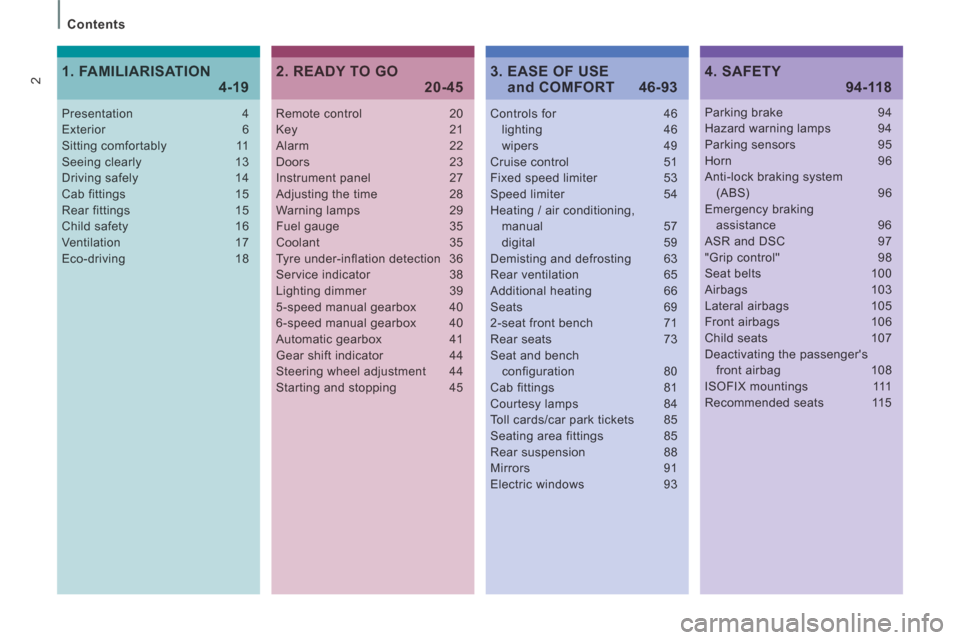
2
Contents
JUMPY-ATLANTE-VP_EN_CHAP00A_SOMMAIRE_ED01-2014
Remote control 20Key 21Alarm 22Doors 23Instrument panel 27Adjusting the time 28Warning lamps 29
Fuel gauge 35Coolant 35Tyre under-inflation detection 36Service indicator 38Lighting dimmer 395-speed manual gearbox 406-speed manual gearbox 40Automatic gearbox 41Gear shift indicator 44Steering wheel adjustment 44Starting and stopping 45
Controls for 46 lighting 46 wipers 49Cruise control 51Fixed speed limiter 53Speed limiter 54Heating / air conditioning,
manual 57 digital 59Demisting and defrosting 63Rear ventilation 65Additional heating 66Seats 692-seat front bench 71Rear seats 73Seat and bench configuration 80Cab fittings 81Courtesy lamps 84Toll cards/car park tickets 85Seating area fittings 85Rear suspension 88Mirrors 91Electric windows 93
Presentation 4Exterior 6Sitting comfortably 11Seeing clearly 13Driving safely 14Cab fittings 15Rear fittings 15
Child safety 16Ventilation 17Eco-driving 18
Parking brake 94Hazard warning lamps 94Parking sensors 95Horn 96Anti-lock braking system (ABS) 96Emergency braking assistance 96ASR and DSC 97"Grip control" 98Seat belts 100Airbags 103Lateral airbags 105Front airbags 106Child seats 107Deactivating the passenger's front airbag 108ISOFIX mountings 111Recommended seats 115
2. READY TO GO 20-454. SAFETY 94-1181. FAMILIARISATION 4-193. EASE OF USE and COMFORT 46-93
Page 20 of 260
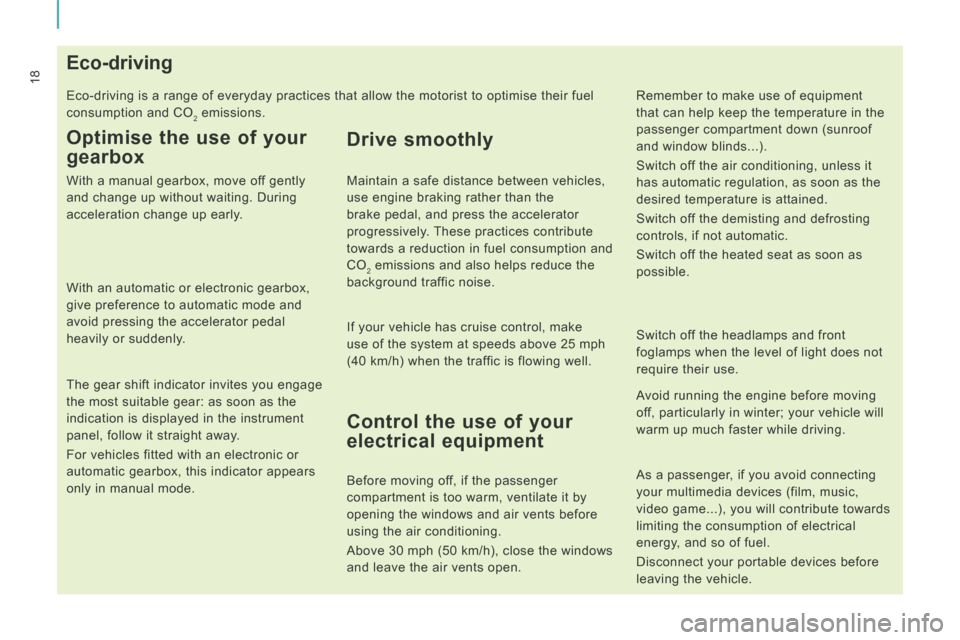
18
JUMPY-ATLANTE-VP_EN_CHAP01_PRISE EN MAIN_ED01-2014
Eco-driving
Eco-driving is a range of everyday practices that allow the motorist to \
optimise their fuel
consumption and CO
2 emissions.
Optimise the use of your
gearbox
With a manual gearbox, move off gently
and change up without waiting. During
acceleration change up early.
With an automatic or electronic gearbox,
give preference to automatic mode and
avoid pressing the accelerator pedal
heavily or suddenly.
Control the use of your
electrical equipment
Before moving off, if the passenger
compartment is too warm, ventilate it by
opening the windows and air vents before
using the air conditioning.
Above 30 mph (50 km/h), close the windows
and leave the air vents open. Switch off the headlamps and front
foglamps when the level of light does not
require their use.
Avoid running the engine before moving
off, particularly in winter; your vehicle will
warm up much faster while driving.
Drive smoothly
Maintain a safe distance between vehicles,
use engine braking rather than the
brake pedal, and press the accelerator
progressively. These practices contribute
towards a reduction in fuel consumption and
CO
2 emissions and also helps reduce the
background traffic noise.
If your vehicle has cruise control, make
use of the system at speeds above 25 mph
(40 km/h) when the traffic is flowing well.
As a passenger, if you avoid connecting
your multimedia devices (film, music,
video game...), you will contribute towards
limiting the consumption of electrical
energy, and so of fuel.
Disconnect your portable devices before
leaving the vehicle. Remember to make use of equipment
that can help keep the temperature in the
passenger compartment down (sunroof
and window blinds...).
Switch off the air conditioning, unless it
has automatic regulation, as soon as the
desired temperature is attained.
Switch off the demisting and defrosting
controls, if not automatic.
Switch off the heated seat as soon as
possible.
The gear shift indicator invites you engage
the most suitable gear: as soon as the
indication is displayed in the instrument
panel, follow it straight away.
For vehicles fitted with an electronic or
automatic gearbox, this indicator appears
only in manual mode.
Page 31 of 260

29
Instruments and controls
READ
Y T
O GO
2
JUMPY-ATLANTE-VP_EN_CHAP02_PRET A PARTIR_ED01-2014
WARNING LAMPS
Each time the engine is started: a series of warning lamps comes on appl\
ying a check auto-test. They go off again almost immediately.
When the engine is running: the warning lamp becomes a warning if it rem\
ains on continuously or flashes. This initial warning may be
accompanied by an audible signal and a message in the screen.
Do not ignore these warnings .
Warning lamp is indicates Solution - action
STOP on, associated
with another
warning
lamp and
accompanied by
a message in the
screen. major faults linked with the
"Brake fluid level", "Engine oil
pressure and temperature",
"Coolant temperature",
"Electronic brake force
distribution" or "Power steering"
warning lamps.
You must stop as soon as it is safe to do so. Park,
switch off the ignition and call a CITROËN dealer or
a qualified workshop.
Parking brake /
Brake fl uid level /
EBFD
on.
parking brake applied or not
released correctly. Releasing the parking brake switches off the warning lamp.
on. low brake fluid level. Top up using a fluid recommended by CITROËN.
remains on, even
though the level
is correct and
associated with the
ABS warning lamp. failure of the electronic brake
force distribution.
You must stop as soon as it is safe to do so. Park,
switch off the ignition and call a CITROËN dealer or
a qualified workshop.
Engine oil
pressure and
temperature
on while driving.
insufficient pressure or
temperature too high. Park, switch off the ignition and allow to cool. Visually
check the level. Chapter 6, "Levels" section.
remains on, even
though the level
is correct. major fault.
Call a CITROËN dealer or a qualified workshop.
Page 35 of 260

33
Instruments and controls
READ
Y T
O GO
2
JUMPY-ATLANTE-VP_EN_CHAP02_PRET A PARTIR_ED01-2014
Warning lamp is indicates Solution-action
Brake pads on. brake pad wear. Have the pads replaced by a CITROËN dealer or a
qualified workshop.
Dipped beam
headlamps /
Daytime running
lamps
on. manual selection or automatic
lighting.
Turn the lighting stalk to the second position.
lighting of the dipped beam headlamps
from the time the ignition is switched
on - daytime running lamps. Depending on the country in which the vehicle is sold.
Chapter 3, "Steering mounted controls" section.
Main beam
headlamps pulling the stalk towards you.
Pull the stalk to return to dipped beam headlamps.
Direction
indicators
flashing with
audible signal. change of direction via the
lighting stalk, to the left of the
steering wheel. To the Right: control to be pushed upwards.
To the Left: control to be pushed downwards.
Front
foglamps
on.
manual selection. The foglamps only operate if the sidelamps or dipped
beam headlamps are on.
Rear foglamps on. manual selection. The lamps only operate if the sidelamps or dipped beam
headlamps are on. In conditions of normal visibility, take
care to switch them off to avoid any penalty. "This light is
a dazzling red."
Particle
emission filter
on. a malfunction of the particle
emissions filter (Diesel additive
level, risk of clogging, ...). Have the filter checked by a CITROËN dealer or a
qualified workshop. Chapter 6, "Checks" section.
Page 39 of 260
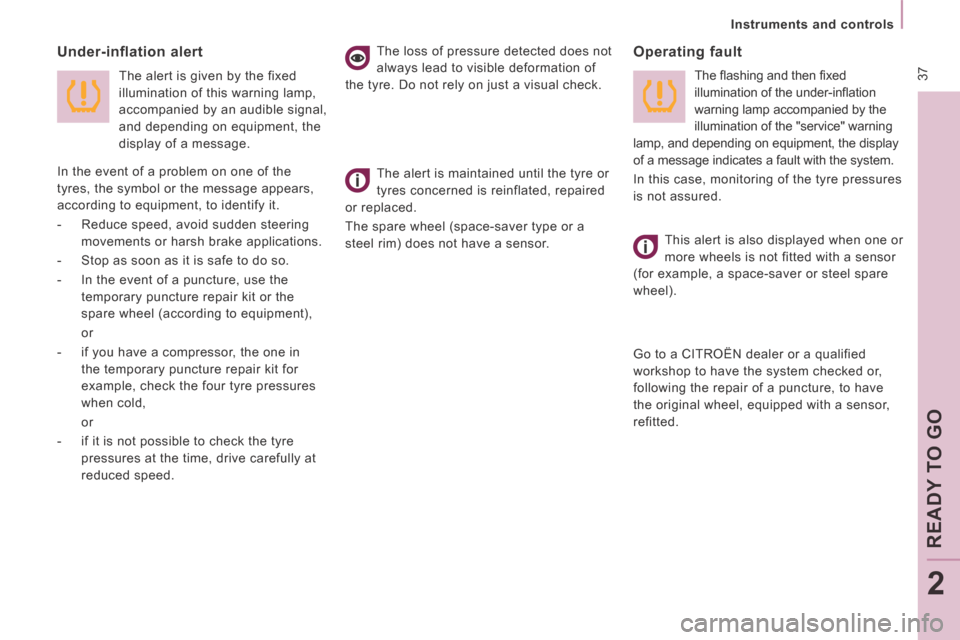
37
Instruments and controls
READ
Y T
O GO
2
JUMPY-ATLANTE-VP_EN_CHAP02_PRET A PARTIR_ED01-2014
This alert is also displayed when one or
more wheels is not fitted with a sensor
(for example, a space-saver or steel spare
wheel).
The alert is maintained until the tyre or
tyres concerned is reinflated, repaired
or replaced.
The spare wheel (space-saver type or a
steel rim) does not have a sensor.
Operating fault
Under-inflation alert
The alert is given by the fixed
illumination of this warning lamp,
accompanied by an audible signal,
and depending on equipment, the
display of a message.
In the event of a problem on one of the
tyres, the symbol or the message appears,
according to equipment, to identify it.
- Reduce speed, avoid sudden steering movements or harsh brake applications.
- Stop as soon as it is safe to do so.
- In the event of a puncture, use the temporary puncture repair kit or the
spare wheel (according to equipment),
or
- if you have a compressor, the one in the temporary puncture repair kit for
example, check the four tyre pressures
when cold,
or
- if it is not possible to check the tyre pressures at the time, drive carefully at
reduced speed. The loss of pressure detected does not
always lead to visible deformation of
the tyre. Do not rely on just a visual check. The fl ashing and then fi xed
illumination of the under-infl ation
warning lamp accompanied by the
illumination of the "service" warning
lamp, and depending on equipment, the display
of a message indicates a fault with the system.
In this case, monitoring of the tyre pressures
is not assured.
Go to a CITROËN dealer or a qualified
workshop to have the system checked or,
following the repair of a puncture, to have
the original wheel, equipped with a sensor,
refitted.
Page 43 of 260

41
Gearboxes and steering wheel
READ
Y T
O GO
2
JUMPY-ATLANTE-VP_EN_CHAP02_PRET A PARTIR_ED01-2014
AUTOMATIC GEARBOX
Selecting positions
- Move the lever select a position. Once the position is selected, the
corresponding indicator lamp appears in
the instrument panel screen.
Park: position of the lever for
parking.
To immobilise the vehicle or start
the engine. Reverse: position of the lever for
reverse gear.
To reverse the vehicle.
Neutral: position of the lever for
neutral.
To park the vehicle (parking brake
on) and start the engine. Drive: position of the lever for
driving.
To move the vehicle forwards in
automatic mode.
Manual: selection of the gears by
pushing or pulling the gear lever
(+ or -).
To move the vehicle forwards in
manual mode.
Page 44 of 260

42
Gearboxes and steering wheel
JUMPY-ATLANTE-VP_EN_CHAP02_PRET A PARTIR_ED01-2014
Moving off
With the engine running, to move off from
position P .
For immediate maximum acceleration
without touching the gear lever,
depress the accelerator pedal to the
extent of its travel, passing the point of
resistance (kickdown). The gearbox will
automatically change down or maintain the
gear selected until maximum engine speed
is reached.
On a descent, the gearbox will automatically
change down in order to provide efficient
engine braking and good pickup.
If you take your foot off the accelerator
suddenly, the gearbox will not change to a
higher gear for reasons of safety.
When stationary with the gear lever in
position D (drive), a vibration limiting device
is activated by pressing the brake pedal.
- gradually release the
pressure on the brake pedal;
the vehicle then moves off.
- Press the brake pedal to
come out of position P ,
- select position R or D ,
- gradually release the pressure on the brake pedal;
the vehicle then moves off.
You can also move off from position N .
- With your foot on the brake, release
the parking brake,
- select position R , D or M ,
- Select position D . The gearbox always selects the most
suitable gear taking account of the following:
- the style of driving,
- the road profile,
- the vehicle load.
The gearbox is then operating in auto-
adaptive mode, without any action on your
part.
Reverse gear
- Select position R
, with the
vehicle stationary and the
engine at idle.
Stopping the vehicle, starting the
engine
- Select position P to
immobilise the vehicle or
to start the engine , with the
parking brake on or off.
If the battery is flat and the gear lever
is in position P , it will be impossible to
change to another position.
- You can also select position N
to park or to start the
engine , with the parking
brake on.
If position N is engaged inadvertently
while driving, allow the engine to return
to idle before engaging position D to restore
drive.
Page 45 of 260

43
Gearboxes and steering wheel
READ
Y T
O GO
2
JUMPY-ATLANTE-VP_EN_CHAP02_PRET A PARTIR_ED01-2014
Manual mode
Manual sequential gear changing.
- Select gear lever position M ,
- push the gear lever towards the + sign to change up, from 1 through to 6,
- conversely, push the gear lever towards the - sign to change down.
In manual mode, it is only possible to
change from one gear to another if the
vehicle speed and engine speed permit.
If they do not, the vehicle will operate
temporarily in automatic mode.
When the vehicle is stationary or moving
very slowly, the gearbox automatically
selects first gear. You can change from position
D
(automatic mode) to position M
(manual mode) at any time.
Good practice
Never select position N when the vehicle is
moving.
Never select positions P or R unless the
vehicle is stationary.
Never change between positions to optimise
braking on a slippery surface.
There is a risk of damage to the gearbox:
- if you press the accelerator and brake pedals at the same time,
- if you force the gear lever from position P to another position in the
event of a battery failure.
When the engine is at idle, brakes not
applied, if position R , D or M is selected the
vehicle moves even without the accelerator
being pressed.
For this reason, do not leave children
unsupervised inside the vehicle, with the
engine running .
Operating fault
Any operating fault is indicated by an
audible signal, accompanied by the
message "Automatic gear fault" in the
screen.
In this situation the gearbox operates in
downgrade mode (locked in 3rd gear). You
may feel a substantial knock when changing
from P to R and from N to R (this will not
cause any damage to the gearbox).
Do not exceed 60 mph (100 km/h), keeping
within the limit of local speed restrictions.
Contact a CITROËN dealer or a qualified
workshop as soon as possible.
When traversing a flooded road or a
ford, drive at walking pace.
Page 54 of 260
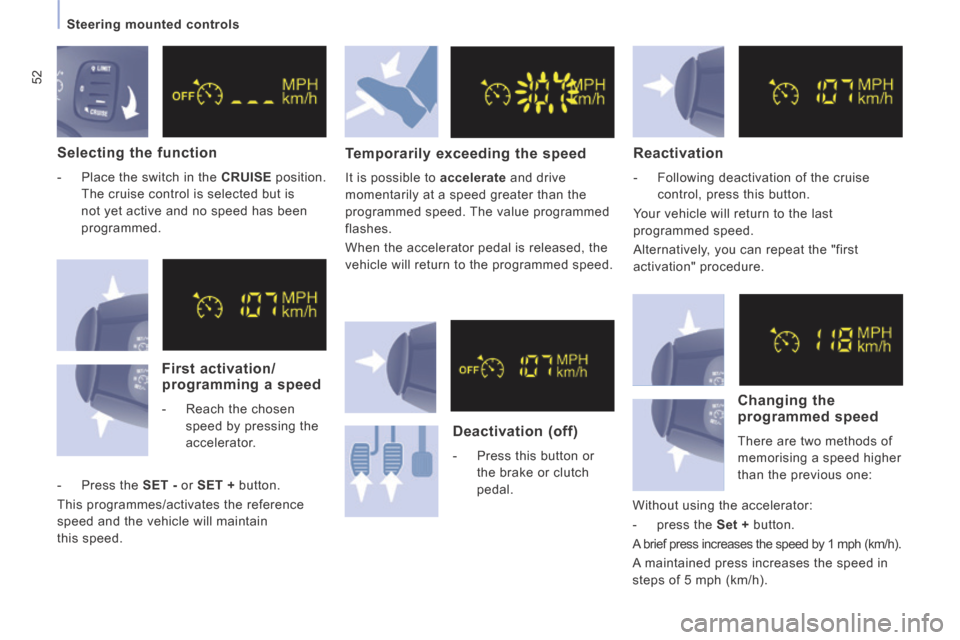
52
Steering mounted controls
JUMPY-ATLANTE-VP_EN_CHAP03_ERGONOMIE ET CONFORT_ED01-2014
Selecting the function
- Place the switch in the CRUISE position.
The cruise control is selected but is
not yet active and no speed has been
programmed.
First activation/programming a speed
- Reach the chosen speed by pressing the
accelerator.
Temporarily exceeding the speed
It is possible to accelerate and drive
momentarily at a speed greater than the
programmed speed. The value programmed
flashes.
When the accelerator pedal is released, the
vehicle will return to the programmed speed.
Reactivation
- Following deactivation of the cruise control, press this button.
Your vehicle will return to the last
programmed speed.
Alternatively, you can repeat the "first
activation" procedure.
Deactivation (off)
- Press this button or the brake or clutch
pedal.
Changing the programmed speed
There are two methods of
memorising a speed higher
than the previous one:
Without using the accelerator:
- press the Set + button.
A brief press increases the speed by 1 mph (km/h).
A maintained press increases the speed in
steps of 5 mph (km/h).
- Press the SET - or
SET + button.
This programmes/activates the reference
speed and the vehicle will maintain
this speed.
Page 90 of 260
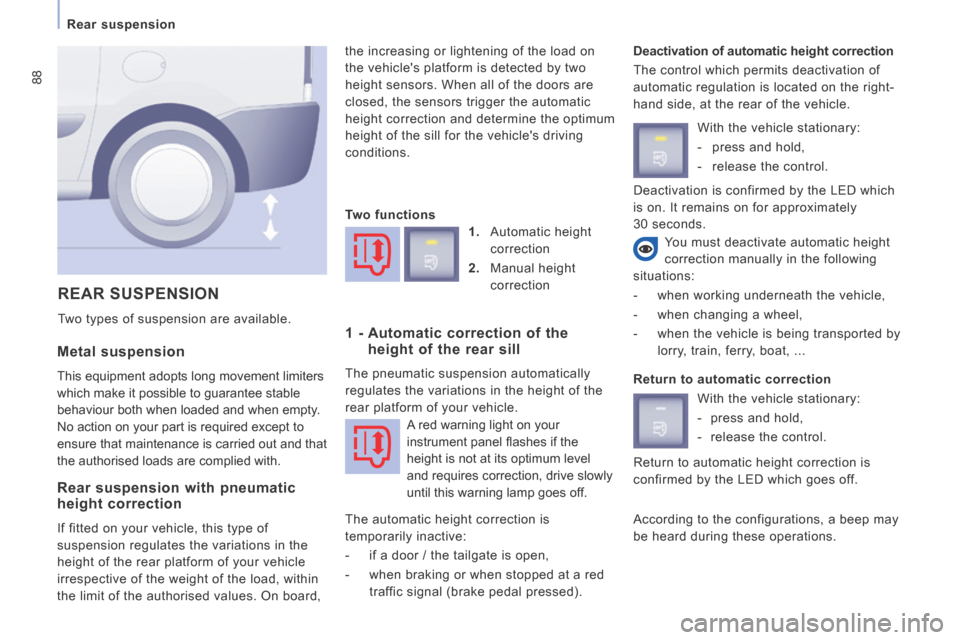
88
Rear suspension
JUMPY-ATLANTE-VP_EN_CHAP03_ERGONOMIE ET CONFORT_ED01-2014
Metal suspension
This equipment adopts long movement limiters
which make it possible to guarantee stable
behaviour both when loaded and when empty.
No action on your part is required except to
ensure that maintenance is carried out and that
the authorised loads are complied with. the increasing or lightening of the load on
the vehicle's platform is detected by two
height sensors. When all of the doors are
closed, the sensors trigger the automatic
height correction and determine the optimum
height of the sill for the vehicle's driving
conditions.
Deactivation of automatic height correction
The control which permits deactivation of
automatic regulation is located on the right-
hand side, at the rear of the vehicle.
REAR SUSPENSION
Two types of suspension are available.
You must deactivate automatic height
correction manually in the following
situations:
- when working underneath the vehicle,
- when changing a wheel,
- when the vehicle is being transported by lorry, train, ferry, boat, ...
Rear suspension with pneumatic height correction
If fitted on your vehicle, this type of
suspension regulates the variations in the
height of the rear platform of your vehicle
irrespective of the weight of the load, within
the limit of the authorised values. On board, Two functions
1. Automatic height correction
2. Manual height correction
1 - Automatic correction of the height of the rear sill
The pneumatic suspension automatically
regulates the variations in the height of the
rear platform of your vehicle.
The automatic height correction is
temporarily inactive:
- if a door / the tailgate is open,
- when braking or when stopped at a red traffic signal (brake pedal pressed). With the vehicle stationary:
- press and hold,
- release the control.
Return to automatic correction With the vehicle stationary:
- press and hold,
- release the control.
According to the configurations, a beep may
be heard during these operations.
A red warning light on your
instrument panel fl ashes if the
height is not at its optimum level
and requires correction, drive slowly
until this warning lamp goes off.
Return to automatic height correction is
confirmed by the LED which goes off. Deactivation is confirmed by the LED which
is on. It remains on for approximately
30 seconds.